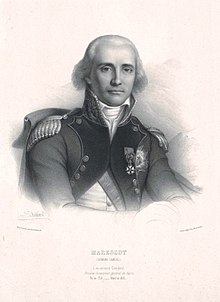Armand Samuel de Marescot
Armand Samuel de Marescot (born March 1, 1758 in Tours , † November 5, 1832 at Chaslay Castle in Montoire-sur-le-Loir ) was a French engineer officer ( Génie militaire ).
biography
Education and family
Marescot came from an old Marescotti family, formerly of Italian origin. He studied at the college in La Flèche and the École militaire in Paris . In 1776 he became an aspirant and then a lieutenant engineer at the École royale du génie de Mézières in Charleville-Mézières in the Ardennes department . In 1784 promoted to lieutenant en premier and in 1891 to capitaine de génie in Lille .
He married Cecile Artis; both had two children who died young.
Northern Army
Marescot served in the Northern Army from 1792. He survived a revolt in the French troops at Tournai , in which General Dillon and Colonel engineer Berthois were murdered and was successful in defending Lille and the sieges of Antwerp , among other things . During the siege of Toulon in 1893 he was appointed commander of a battalion and earned military service in the field. In 1794 he took command of the Maubeuge engineering troops and successfully carried out the siege of Charleroi , Landrecies and Maastricht (Nov. 8, 1794). He was promoted to Colonel , shortly afterwards in 1794 to Général de brigade and after his participation in the Battle of Fleurus in the First Coalition War promoted to Général de division . Regardless of these merits, the Parisian revolutionary rule put him on an emigrant list in 1794 and expropriated his and his wife's property. However, General Carnot managed to get rehabilitated and his goods back. In March 1795 he became inspector general of the engineering troops in Bayonne in the area of the army on the Eastern Pyrenees .
In Germany
In 1796 Marescot took command in Landau in the Palatinate , commanded the engineering corps of the French Army on the Rhine and in 1797 defended the Kehl fortress in the attacks of the Austrian Lieutenant Field Marshal Friedrich von Hotze . From 1797 to 1799 he commanded various engineering corps in the French army a. a. in the successful Helvetic Army . In 1799 he became military governor of the Mainz fortress and inspector general of the engineering troops there. He accompanied Napoleon Bonaparte on the Italian campaign in 1799/1800 , besieged the fortress of Bard in Savoy and took part in the victorious battle of Marengo . He then led from 1802 to 1804/05 in Rochefort the chairmanship of the committee for the fortifications on the west coast and carried out the coastal inspections with Admiral François Étienne de Rosily-Mesros . As the first inspector of the engineering troops in 1804/05, he was awarded the Order of the Legion of Honor as a Grand Officer . In 1805 he took part with the Grande Armée in the battle of Austerlitz against Austria and Russia .
In 1808 he became comte de l'Empire , i.e. Imperial Count, of the First Empire under Napoleon Bonaparte.
War in Spain
During the Napoleonic war on the Iberian Peninsula against Spain , Marescot inspected the occupied territories and commanded the engineering corps. After a short and costly battle in the Battle of Bailén under the leadership of General Pierre Dupont de l'Étang , this French army had to surrender in July 1808. Generals de l'Étang and Marescot and the army were taken prisoner by the Spanish. In 1808, after returning to France, de l'Étang and Marescot were arrested and brought to court. They were not convicted, but on imperial orders, Marescot was banished to Tours until 1812 and never reinstated.
Pair of France
In 1814 the interim government of King Louis XVIII appointed him . first inspector of the engineering troops of France. After the rule of the Hundred Days by Emperor Napoleon in 1815, where he served as an inspector in the Vosges , he was first dismissed by the king and then reinstated as chief inspector and head of the defense commission on the intervention of Minister of War St. Cyr .
In October 1815 he became Marquis of France and in 1819 a member of the Chambre des Pairs . As an officer, he retired from military service in 1818.
Honors
- Ordre royal et militaire de Saint-Louis
- Member of the Académie des sciences (1796)
- Order of the Legion of Honor (1805)
- Comte de l'Empire (1808)
- Marquis of France (1815)
- Name on the Arc de Triomphe in Paris (1832)
literature
- Charles Mullié: Armand Samuel de Marescot Biographie des célébrités militaires des armées de terre et de mer de 1789 à 1850 . 1852.
- Karl Reichard: Modern biographies, or short news of the life and deeds of the most famous people . Leipzig 1811.
- Karl Florentin Leidenfrost : French Heldensaal or the life, deeds and current fates of the most memorable heroes of the republic and the empire, in particular of Napoleon's comrades in arms and marshals . Publishing house Bernhard Friedrich Voigt, Ilmenau 1828.
Individual evidence
- ^ List of members since 1666: Letter M. Académie des sciences, accessed on January 19, 2020 (French).
| personal data | |
|---|---|
| SURNAME | Marescot, Armand Samuel de |
| BRIEF DESCRIPTION | French engineer officer |
| DATE OF BIRTH | March 1, 1758 |
| PLACE OF BIRTH | Tours |
| DATE OF DEATH | November 5, 1832 |
| Place of death | Montoire-sur-le-Loir |

